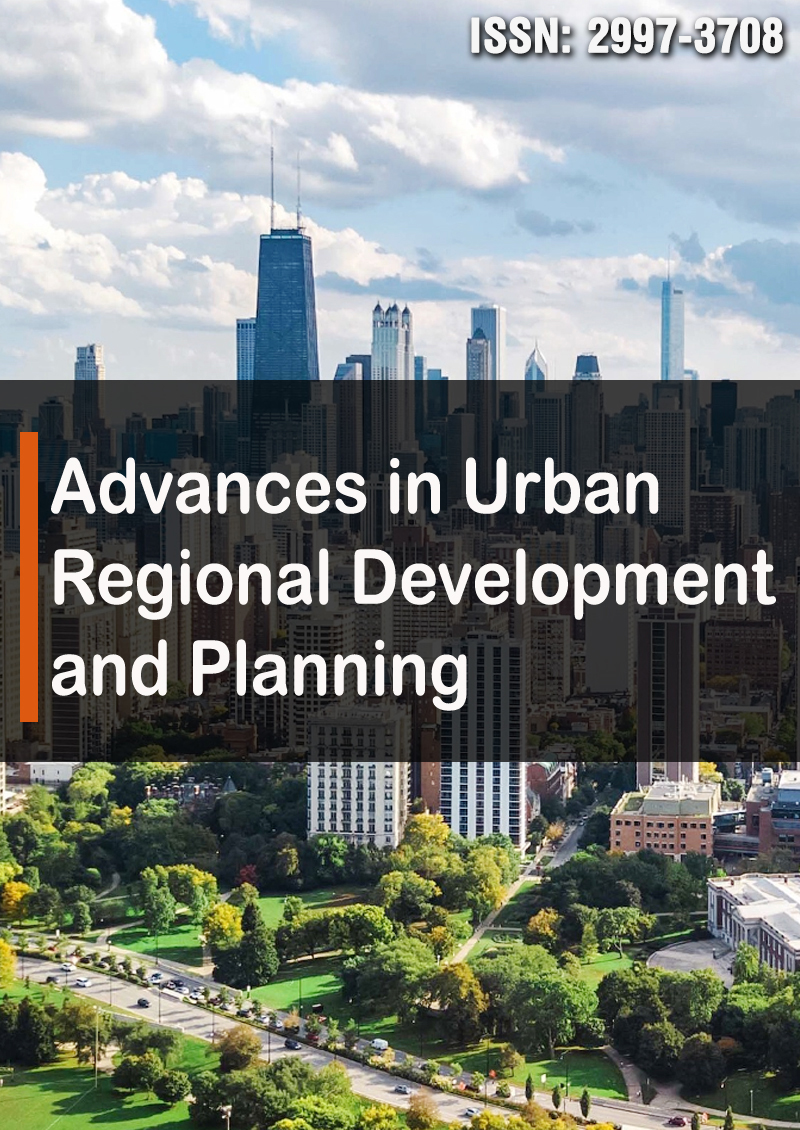Research Article - (2025) Volume 2, Issue 1
Enhanced Rock Weathering in Sandy Soils: Carbon Removal Potential and Fertility Restoration in Future Urbanization Zones
2Department of Geology, University of Mandalay, Mandalay, Myanmar
3Faculty of Engineering, Hokkaido University, Hokkaido, Japan
Received Date: Mar 20, 2025 / Accepted Date: Apr 25, 2025 / Published Date: May 05, 2025
Copyright: ©2025 Hkaung Htut San, et al. This is an open-access article distributed under the terms of the Creative Commons Attribution License, which permits unrestricted use, distribution, and reproduction in any medium, provided the original author and source are credited.
Citation: San, H. H., Pyone, K., Sato, T. (2025). Enhanced Rock Weathering in Sandy Soils: Carbon Removal Potential and Fertility Restoration in Future Urbanization Zones. Adv Urban Region Dev Plann, 2(1), 01-09.
Abstract
Enhanced Rock Weathering (ERW) has emerged as a promising Negative Emission Technology due to its dual role in atmospheric carbon dioxide removal (CDR) and soil fertility restoration. While most ERW research focuses on fertile croplands, its application in agriculturally marginal areas remains underexplored. This study investigates the efficacy of basalt-based ERW in sandy soils within Future Urbanization Zones of Kyaukse and Sintgaing townships, Mandalay Division, Myanmar, a site characterized by poor water retention, low nutrient content, and limited agricultural viability. Small-scale plantation and extraction experiments were conducted using different soil-to-basalt ratios to assess impacts on plant growth, soil mineralogy, and porewater chemistry. Eggplant growth was notably enhanced in moderate basalt-amended soils (ratios 0.9:0.1 and 0.5:0.5), while mineralogical anal- ysis revealed increased diversity in nutrient-bearing minerals like plagioclase and augite. Corresponding increases in pH and essential cations (Ca2+, Mg2+) further highlighted the potential of basalt in improving soil geochemistry. Complementary one-di- mensional reactive transport modeling validated experimental trends and estimated long-term dissolution and CDR potential. Simulation results showed that 3% of applied basalt (1.2 t ha−1 yr−1) dissolved annually, leading to a modeled CDR efficiency of 0.31 tCO2 ha−1 yr−1 under field-representative conditions. These findings demonstrate that basalt-ERW can enhance soil function- ality and sequester atmospheric CO2 even in degraded environments. This study extends the applicability of ERW beyond tradi- tional croplands and offers a sustainable strategy for land restoration in rapidly urbanizing and vulnerable ecosystems.
Keywords
Enhanced Rock Weathering, Carbon Dioxide Removal, Sandy Soils, Basalt Amendment, Soil Fertility Restoration.
Introduction
Enhanced Rock Weathering (ERW), accelerating the natural weathering rate of rocks, is gaining traction among the Negative Emission Technologies due to its dual potential for Carbon Dioxide Removal (CDR) and soil fertility enhancement [1-3]. Among the rocks used for ERW, basalt (a mafic igneous rock rich in calcium and magnesium silicates) is particularly promising [4]. Its high weathering reactivity, abundance of essential cations (Ca²âº, Mg²âº) for CDR, and global availability from active mining sites make it a practical choice [5-8].
However, most ERW research has focused on fertile croplands, where basalt amendments improve yields while sequestering COâ?? [9-12]. Critical gaps remain in assessing the efficiency of ERW in marginal, agriculturally degraded areas, particularly sandy soils. These soils, dominated by coarse particles (0.05–2 mm), exhibit poor water retention, low nutrient-holding capacity, and rapid leaching [13-15]. Such limitations pose significant challenges for land rehabilitation, especially in Future Urbanization Zones (FUZs) where soil degradation threatens sustainable urban development [16-19].
To address this gap, this study evaluates the potential of basalt- ERW in a sandy soil area of selected FUZs in Myanmar, combining: (1) Small-scale trials to measure impacts on soil fertility and plant growth and (2) Modeling assessments to quantify long-term CDR potential. By focusing on agriculturally marginal lands, this work aims to expand the applicability of ERW beyond traditional croplands, offering solutions for land restoration and substantial urbanization in vulnerable ecosystems.
Material and Method
Study Area and Basalt Selection
A non-agricultural area (~7.3 acres) on the southeastern flank of Kyaukse FUZs, Kyaukse and Sintgaing Townships, Mandalay Division, Myanmar, was selected for this study (Fig. 1). Despite being surrounded by active croplands, local farmers reported that the site itself is unsuitable for cultivation. Previous attempts to utilize the land involved planting grapefruit trees along its periphery after replacing ~5 meters of topsoil with terrestrial soil. However, low survival and growth rates of the grapefruit plants persisted, highlighting the inherent soil limitations of study area. These conditions make it an ideal candidate for testing basalt- ERW as a strategy for soil fertility restoration in marginal lands.
Due to the lack of a basalt source or active mining site near the study area, the Popa basalt, located approximately 130 km to the southwest, was selected for the experiments. Rietveld analysis revealed its composition as 23.6 wt% augite, 19.1 wt% bytownite, 30.8 wt% labradorite, 1.6 wt% ilmenite and 24.9 % matrix (Fig. 2E). Given this mineralogy, the Popa basalt has high potential to release essential nutrients, particularly calcium (Ca) and magnesium (Mg), which could significantly enhance soil fertility in the study area.
Analytical Methods
Soil Sampling
To obtain representative soil samples from the study area, topsoil samples (within a 0.5-1 m depth) were collected from seven locations (A-1 to A-7) after removing 0.5 m uppermost soil layer (Extended Fig. E1). During sample collection, sieving with 5 mm mesh size was performed to remove unwanted materials and organic matter. The collected samples were then air-dried for two weeks at room temperature to remove excess moisture before further experiments.
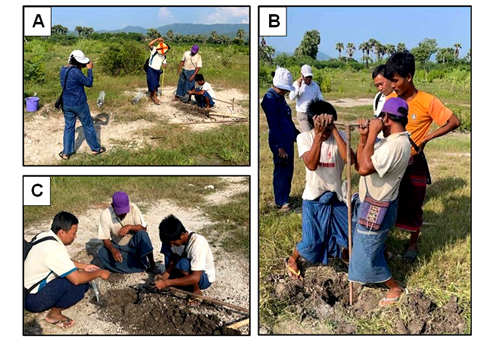
Extended Figure E1: Soil Sample Collection: (A) Recording and mapping the sampling points, (B) Drilling up to a depth of 5 m after removing the uppermost soil layers, and (C) Collecting representative soil samples from the target depth after sieving.2.2.2 Mineralogical Characterization
X-ray diffraction (XRD, Miniflex, Rigaku) analysis using cobalt tube was primarily conducted to characterize the mineralogical qualification and quantification. Before XRD analysis, the samples (both soil and basalt) were dried in a temperature-controlled chamber at 25°C for 24 hours to eliminate moisture. Subsequently, the samples were manually ground with an agate mortar and pestle to a particle size of <10 μm in diameter. Scanning was conducted at 40 kV and 15 mA within the range of 5° to 85° 2θ (Co-Ka), with a scanning rate of 1° per minute and a step of 0.01°.
Solution Analysis
The concentration changes of targeted major cations were analyzed using Inductively Coupled Plasma-Atomic Emission Spectroscopy (ICP-AES: Pro XP Duo, Thermo Scientific). Samples were prepared using Milli-Q water with a dilution factor of 10, and ICP multi-element standard solution IV (Supelco, Germany) was used as the calibration standard. Repeated analyses were conducted to determine the instrumental detection limits.
Preparation for Experiments
Two types of small-scale basalt-ERW experiments were conducted: (1) plantation experiments to assess the potential in a natural system and (2) extraction tests to determine the maximum potential. The A-7 soil sample was selected for these experiments due to its representativeness (Fig. 1). Prior to the experiments, the soil sample was mixed with ground basalt powder with diameter<125 μm in four different weight ratios (soil: basalt): (A) 1:0, (B) 0.9:0.1, (C) 0.5:0.5, and (D) 0.4:0.6. For plantation experiments, four three-week-old eggplants were planted in plastic pots (11 cm wide × 15 cm deep), each filled with the respective soil mixtures. The experiments were monitored for 31 days, with regular irrigation conducted once per day using tap water. Leachate from the pots was collected and analyzed to determine changes in pH and the concentrations of targeted major cations (Ca2+ and Mg2+).
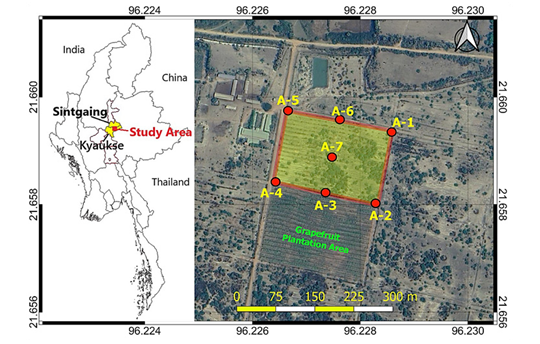
Figure 1: Location of Study Area (red-rectangle) and Soil Sampling Points (red-dots). Generated by QGIS (v.3.22.5).
For the extraction tests, 1 g of each of the four soil mixtures was dissolved in 50 mL of synthetic rainwater (pH 5.5), which was prepared by diluting nitric acid in deionized water and adjusting the pH with sodium bicarbonate. The sample-containing tubes were shaken for 96 hours, with fluid samples collected at 5 hours, 24 hours, 72 hours, and 95 hours for analysis.
Modeling Concept and Reproduction
For assessment of basalt powder efficiencies and interpretation of the experimental results, one-dimensional reactive transport modeling (1-D RTM, for plantation experiments) was conducted. The 1-D RTM was developed based on the study by, and all simulations were performed using the 2023 professional package of Geochemist’s Workbench (GWB) software [5]. With this modeling, the thermodynamic database of the French Geological Institute (Thermoddem-BRGM), specifically GWB_Thermoddem V1.10_15Dec2020.dat, was applied [20].
The 1-D RTM was developed in accordance with the reference model (i.e., maintaining the same modeling size, porewater chemistry, infiltration rate, and porosity) as described by [5]. Subsequently, the reactant minerals were switched into experimental data with desirable mass and the total mass input was incrementally increased. This approach enabled the determination of the maximum deployable mass per hectare area.
The reliability of the 1-D RTM was assessed by comparing its output to the dissolution efficiency of alkali basalts reported in a reference study. For this purpose, a simulation domain equivalent to one hectare was established, consisting of ten layers, a total of 15 mm thick. The simulation was conducted using a fixed infiltration rate of synthetic rainwater at 1200 mm per year, as adopted from Beerling et al [5]. The model results showed trends that closely matched the reference data, indicating that the developed 1-D RTM is suitable for estimating the maximum annual mass of materials that can be effectively deployed per hectare (Extended Fig. E2).
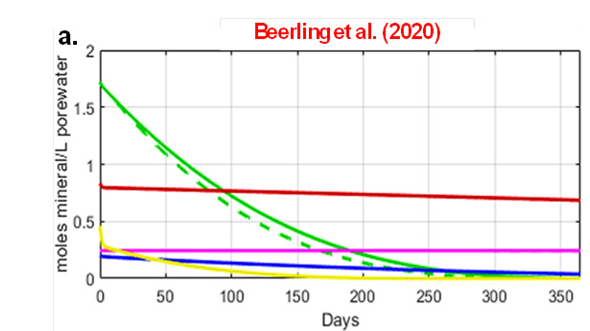
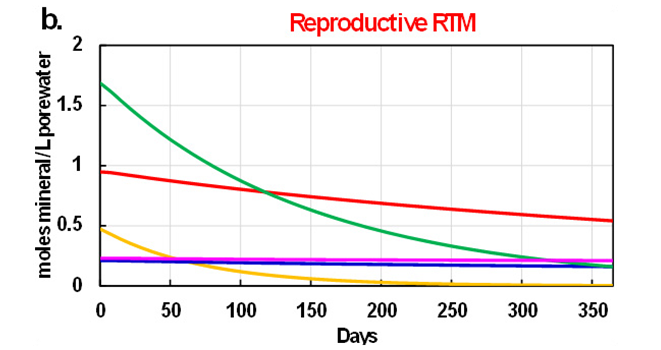
Extended Figure E2: Model validation of 1-D Reactive Transport Model (RTM) against Beerling et al. (2020) benchmark data. (a) Original published results versus (b) this study implementation, both simulating 40 t ha-¹ of 10-μm alkali basalt weathering under 1200 mm yr-¹water infiltration. Minor discrepancies likely reflect differences in: (i) mineral-specific surface area assumptions, (ii) infiltrating water chemistry (pH, ionic strength), and (iii) secondary mineral precipitation parameters not fully specified in the reference study.
CDR Calculation
CDR efficiency of this study followed according to the CDR calculation pathway-2 by Beerling et al. [5]. This pathway includes the liberated targeted major cations from the dissolution of basalt are transported to the ocean via surface runoffs and account as ocean-based CDR (Eq. 1).
Dissolution of silicate minerals in AMD (e.g., wollastonite: CaSiO3):

CDR in this study is then calculated by the following equation where one mol of divalent cation removed 1.72 mol of CO2 from the atmosphere.

where η is the CDR efficiency of the ocean (here η = 0.86) (Beerling et al. 2020) and 44 is the molecular weight of CO2.
Results
Changes in Soil Mineralogy Following Basalt Amendment The Rietveld mineralogical quantification revealed notable changes in soil mineralogy following the addition of basalt powder at three different soil: basalt ratios: 0.9:0.1, 0.5:0.5, and 0.4:0.6. The untreated soil exhibited a relatively limited mineral composition, predominantly consisting of quartz, calcite, dolomite, and muscovite (Fig. 2A). After the incorporation of basalt powder, the mineralogical profile became more diverse across all amended samples. New mineral phases corresponding to basalt-derived components were identified, including plagioclase feldspars (bytownite and labradorite), pyroxene (augite), and trace amounts of ilmenite, confirming the successful integration of basalt into the soil matrix.
Among the tested ratios, the 0.4:0.6 mixture displayed the highestdegree of new mineral incorporation because of the highest basalt content. However, even the 0.9:0.1 mixture exhibited a significant broadening of the mineralogical components (Fig. 2B-D). Therefore, these results highlight the potential of basalt-enhanced weathering to diversify the mineral content of nutrient-deficient sandy soils, which may improve their geochemical reactivity and long-term nutrient release capacity.
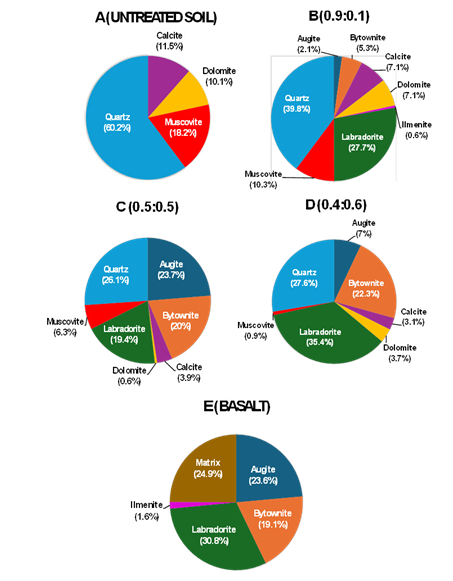
Figure 2: Mineralogical composition variations. (A) Untreated soil, (B-D) soil-basalt mixtures with increasing basalt content, and (E) pure basalt. The untreated soil (A) shows quartz dominance, confirming a sandy soil composition. Basalt-amended samples (B-D) exhibit progressive mineralogical changes, while (E) displays characteristic basalt mineralogy
Growth Rate of Eggplants
Eggplant growth ordinarily depends on a balanced supply of macronutrients (N, P, K, Ca, Mg) and essential micronutrients (Fe, Zn, Mn, Cu), as well as beneficial elements such as Si and Na [21,22]. While basalt lacks significant nitrogen (N) and phosphorus (P), its mineral composition is rich in weatherable Ca-Mg silicate minerals and provides a steady source of Na, K, and Fe, which are critical for plant growth. The plantation experiments demonstrated varying eggplant growth across the different soil treatments.
Eggplants grown in the 0.9:0.1 and 0.5:0.5 mixtures exhibited the most vigorous and sustained growth, suggesting that these ratios provided a better balance of nutrient availability (Fig. 3C- D). In contrast, plants in the untreated (1:0) soil showed signs of nutrient deficiency, while those in the highest basalt concentration (0.4:0.6) displayed the weakest growth performance (Fig. 3B, E). This indicates that while basalt amendment enhances soil fertility by releasing essential ions over time, excessive basalt content may initially hinder plant growth, possibly due to altered soil physics and chemistry. These findings underscore the importance of optimizing basalt application rates to maximize plant growth benefits while avoiding potential negative effects.
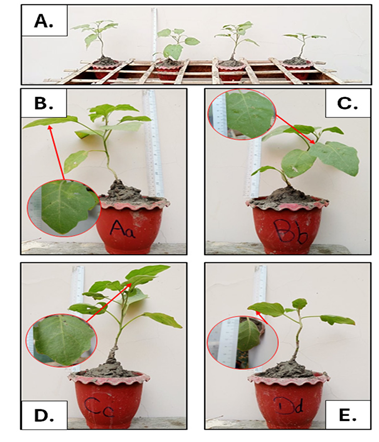
Figure 3: Effects of basalt amendment on eggplant growth after 31 days. (A) Experimental setup overview. (B-E) Growth comparison after 31 days: (B) control (soil:basalt = 1:0), (C) 0.9:0.1 mixture, (D) 0.5:0.5 mixture, and (E) 0.4:0.6 mixture. Visual assessment reveals an inverse relationship between basalt content and plant growth rate, with higher basalt ratios correlating with reduced eggplant development.
Changes in Leachate Solution Chemistry Across Different Basalt Amendment Ratios
The porewater chemistry exhibited measurable changes in response to basalt powder amendments, as observed in both the extraction tests and the plantation experiments. Across all soil-to- basalt ratios, the pH of the porewater showed an initial increase due to basalt dissolution. In the extraction tests, the pH rose within the first 5 hours and peaked by 24 hours, followed by a gradual decline through 72 to 96 hours (Fig. 4A). Although unstable trend was observed in the plantation trials, the porewater pH increased progressively over the 31-day monitoring period (Fig. 4B). Despite this pH level fluctuations, pH levels of basalt amended soils remained higher than the unamended control, suggesting a sustained buffering effect from basalt dissolution.
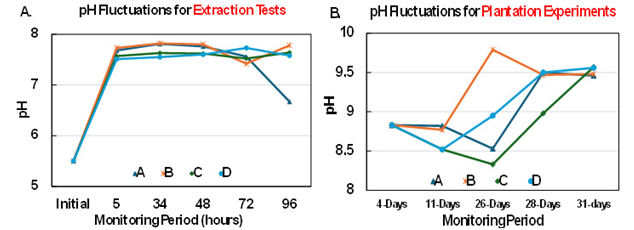
Figure 4: pH evolution in leachate solutions during (A) Extraction tests which showed progressive pH increases in basalt-mixed soils throughout 96 hours, while untreated soil exhibited late-stage pH decline (96h), suggesting depletion of carbonate minerals (calcite/ dolomite). Continued pH rise in mixed soils indicates sustained mineral dissolution releasing buffer ions (Ca²Ã¢Âº/Mg²Ã¢Âº). (B) Plantation experiments results demonstrated pH fluctuations with overall increasing trends over 31 days, where organic matter and biological activity likely contributed to pH variations alongside mineral dissolution
In addition to pH, the concentrations of key major cations, particularly Ca²Ã¢Âº and Mg²Ã¢Âº, showed a consistent and significant increase across all amendment ratios (Fig. 5). These elements, derived from the weathering of basaltic minerals such as plagioclase and olivine, were released progressively over time, with higher concentrations corresponding to higher basalt content. The most notable increases were observed in the 0.4:0.6 (soil:basalt) treatment, indicating enhanced mineral dissolution at higher basalt loadings.
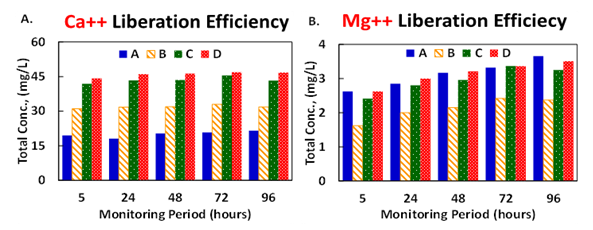
Figure 5: Major cation evolution in leachate solutions during extraction tests: (A) Ca²Ã¢Âº concentrations showed progressive increases with higher basalt ratios (1:0 to 0.4:0.6) over 96 hours, demonstrating sustained calcium release from basalt dissolution. (B) Mg²Ã¢Âº levels were consistently higher in untreated soil (containing dolomite) than basalt mixtures, reflecting faster magnesium release from carbonates (i.e., dolomite) versus silicates (e.g., augite). Both trends confirm basalt amendments can provide long-term nutrient supplementation to sandy soils.
These trends suggest that basalt addition not only alters the chemical environment of the soil solution but also contributes to the gradual release of essential nutrients. These changes are indicative of the potential for enhanced nutrient availability and soil fertility improvements over time, particularly in sandy soils with initially low bioavailable mineral and nutrient.
Estimation of CDR Efficiency and Annual Basalt Dissolution via Models
To evaluate the potential of ERW for CDR in this study, both the annual basalt dissolution rate and associated CDR efficiency were estimated using 1-D RTM. A total of 40 tons of alkali basalt was modeled as an initial application rate within a one-hectare cropland area [5]. Using a 1-D RTM approach, the simulation accounted for key parameters such as rainfall infiltration, mineral composition, and soil profile. The results indicated that, under the given hydrological and geochemical conditions, only 1.2 tons of the applied basalt underwent dissolution within the first year (Fig. 6A-D). This represents approximately 3% of the total applied mass, highlighting the relatively slow rate of mineral weathering under field-representative conditions.
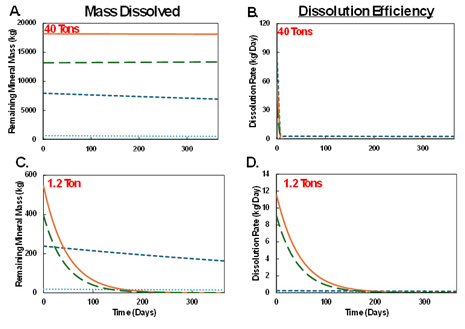
Figure 6: Simulated basalt weathering efficiencies at field scale. (A-B) Limited dissolution (3% of 40-ton deployment) versus (C-D) near-complete dissolution (95% of 1.2-ton deployment) under identical climatic conditions (1-ha domain, 1200 mm/yr rainfall).
Subsequently, the 1.2 tons of dissolved basalt was input into the 1-D RTM to estimate its carbon sequestration potential. Using the CDR estimation equation proposed by Eq. 3, the model yielded a CDR efficiency of 0.31 tCOâ?? ha⻹ yr⻹. This value reflects the carbon dioxide removed from the atmosphere through chemical weathering reactions, particularly the neutralization of protons and capture of COâ?? as bicarbonate in the aqueous phase [5].
Discussion
This study investigated the feasibility of basalt-ERW as a dual- purpose strategy for soil fertility restoration and atmospheric CDR in agriculturally marginal sandy soils within the selected FZUs of Myanmar. The outcomes of basalt amendment trials, both experimental and modeling-based, provide critical insight into broader applicability of basalt-ERW in degraded urban fringe environments where conventional soil remediation methods remain techno-economic challenges.
The untreated soil primarily contained quartz and muscovite, offering limited bioavailable nutrient value because of their high resistance to weathering. In contrast, basalt-amended showed the presence of minerals like plagioclase and augite, which are richer in essential nutrients such as calcium and magnesium. In consequences, although these newly introduced basalt-derived minerals are known for their slow dissolution but sustained release of essential plant nutrients (e.g., Ca²âº, Mg²âº, Fe²âº), enhancing the geochemical reactivity of the soil and promoting long-term fertility restoration. This shift toward a more diverse and reactive mineral composition supports the hypothesis that basalt can gradually reengineer the nutrient profile of nutrient-poor sandy substrates.
Correspondingly, the growth performance of eggplants under different soil treatments revealed significant biological responses to basalt application. The most vigorous growth was observed in soils amended at 0.9:0.1 and 0.5:0.5 ratios, suggesting an optimal balance between nutrient release and plant accessibility. In contrast, the control (unamended soil) exhibited signs of nutrient deficiency, while the highest basalt content (0.4:0.6) unexpectedly suppressed plant growth. This suggests that excessive basalt application may create adverse chemical conditions such as abrupt shifts in pH that inhibit nutrient uptake and physical condition such as water retention, etc [23]. These findings underscore the importance of tailoring basalt-ERW applications to site-specific conditions and optimizing amendment rates to avoid detrimental effects on early plant growth.
Changes in porewater chemistry further confirmed the influence of basalt on soil processes. Both short-term extraction tests and longer plantation trials showed a clear increase in pH and maintenance of the pH across all amended soils, indicating buffering effect of basalt through proton consumption during silicate dissolution. These shifts contribute to better plant nutrient availability and stabilize at higher levels throughout the plantation period, reinforcing the soil pH maintenance. Therefore, basalt amendment can sustain the long-term availability of crucial nutrients while concurrently modifying the soil chemical environment in favor of plant growth
and microbial activity.
Based on the modeled dissolution dynamics and using pathway-2 CDR estimation of Beerling et al. the resultant carbon removal potential was calculated at 0.31 tCOâ?? ha⻹ yr⻹ per 1.2 tons of basalt dissolution [5]. This value, while modest, is significant when scaled across larger urbanizing landscapes with marginal soils, suggesting that basalt-ERW could play a meaningful role in coupling urban development with climate mitigation and land restoration goals. Furthermore, the reliable performance of the 1-D RTM model affirms its utility for scaling field trials and guiding basalt application strategies in data-scarce regions.
In summary, this study confirms that ERW, particularly using basalt amendments, can substantially enhance the fertility of degraded sandy soils while contributing to measurable carbon removal. The combination of mineralogical diversification, improved plant growth, chemical buffering, and validated modeling outcomes collectively support the deployment of ERW as a viable nature-based solution for soil rehabilitation in urbanizing and ecologically vulnerable zones. Strategic implementation of ERW in such contexts could not only alleviate land degradation but also advance climate resilience and sustainable urban planning across the Global South [23].
References
1. Beerling, D. J. (2017). Enhanced rock weathering: biological climate change mitigation with co-benefits for food security?. Biology letters, 13(4), 20170149.
2. Edwards, D. P., Lim, F., James, R. H., Pearce, C. R., Scholes, J., Freckleton, R. P., & Beerling, D. J. (2017). Climate change mitigation: potential benefits and pitfalls of enhanced rock weathering in tropical agriculture. Biology letters, 13(4), 20160715.
3. Vakilifard, N., Kantzas, E. P., Edwards, N. R., Holden, P. B., & Beerling, D. J. (2021). The role of enhanced rock weathering deployment with agriculture in limiting future warming and protecting coral reefs. Environmental Research Letters, 16(9), 094005.
4. te Pas, E. E., Hagens, M., & Comans, R. N. (2023). Assessment of the enhanced weathering potential of different silicate minerals to improve soil quality and sequester CO2. Frontiers in Climate, 4, 954064.
5. Dessert, C., Dupré, B., Gaillardet, J., François, L. M., & Allègre, C. J. (2003). Basalt weathering laws and the impact of basalt weathering on the global carbon cycle. Chemical Geology, 202(3-4), 257-273.
6. Linke, T., Oelkers, E. H., Dideriksen, K., Möckel, S. C., Nilabh, S., Grandia, F., & Gislason, S. R. (2024). The geochemical evolution of basalt Enhanced Rock Weathering systems quantified from a natural analogue. Geochimica et Cosmochimica Acta, 370, 66-77.
7. Lewis, A. L., Sarkar, B., Wade, P., Kemp, S. J., Hodson, M. E., Taylor, L. L., ... & Beerling, D. J. (2021). Effects of mineralogy, chemistry and physical properties of basalts on carbon capture potential and plant-nutrient element release via enhanced weathering. Applied Geochemistry, 132, 105023.
8. Beerling, D. J., Kantzas, E. P., Lomas, M. R., Wade, P., Eufrasio, R. M., Renforth, P., ... & Banwart, S. A. (2020). Potential for large-scale CO2 removal via enhanced rock weathering with croplands. Nature, 583(7815), 242-248.
9. Beerling, D. J., Leake, J. R., Long, S. P., Scholes, J. D., Ton, J., Nelson, P. N., ... & Hansen, J. (2018). Farming with crops and rocks to address global climate, food and soil security. Nature plants, 4(3), 138-147.
10. Baek, S. H., Kanzaki, Y., Lora, J. M., Planavsky, N., Reinhard, C. T., & Zhang, S. (2023). Impact of climate on the global capacity for enhanced rock weathering on croplands. Earth's Future, 11(8), e2023EF003698.
11. Kantzas, E. P., Val Martin, M., Lomas, M. R., Eufrasio, R. M., Renforth, P., Lewis, A. L., ... & Beerling, D. J. (2022). Substantial carbon drawdown potential from enhanced rock weathering in the United Kingdom. Nature Geoscience, 15(5), 382-389.
12. Swoboda, P., Döring, T. F., & Hamer, M. (2022). Remineralizing soils? The agricultural usage of silicate rock powders: A review. Science of The Total Environment, 807, 150976.
13. Osman, K. T., & Osman, K. T. (2018). Sandy soils. Management of soil problems, 37-65.
14. Ramya, Razanah. (2023). Sandy Soil: Advantages and Disadvantages. In, 1–40.
15. Bruand, A., Hartmann, C., & Lesturgez, G. (2005). Physical properties of tropical sandy soils: A large range of behaviours. In Management of Tropical Sandy Soils for Sustainable Agriculture. A holistic approach for sustainable development of problem soils in the tropics.
16. Ahn, Y. J., Koriyev, M., & Juraev, Z. (2024). Urban Soil Dynamics: The Relationship Between Soil Health and Urbanization. Journal of Asian Geography, 3(2), 62-69.
17. Huang, J., & Hartemink, A. E. (2020). Soil and environmental issues in sandy soils. Earth-Science Reviews, 208, 103295.
18. MešiÃÂ?ÂÂek, T., Mirjana, Knezevic, M., StojanoviÃÂ??, N., Lisica, A. (2018). The Impact of Urbanization on Soils.
19. de Holanda, S. F., Vargas, L. K., & Granada, C. E. (2025). Challenges for sustainable production in sandy soils: A review. Environment, Development and Sustainability, 27(1), 53-66.
20. Blanc, P., Lassin, A., Piantone, P., Azaroual, M., Jacquemet, N., Fabbri, A., & Gaucher, E. C. (2012). Thermoddem: A geochemical database focused on low temperature water/ rock interactions and waste materials. Applied geochemistry, 27(10), 2107-2116.
21. Sharma, M., & Kaushik, P. (2021). Biochemical composition of eggplant fruits: A review. Applied sciences, 11(15), 7078.
22. Prusty, M., PANDA, N., Dash, A. K., & Mishra, N. (2022). Nutrient Management Modules for Eggplant (Solanum melongena L.): Yield, Quality, Economics, Nutrient Uptake and Post-harvest Soil Properties. Journal of the Indian Society of Coastal Agricultural Research, 40(1).
23. Neenu, S., & Karthika, K. S. (2019). Aluminium toxicity in soil and plants. Harit Dhara, 2(1), 15-19.


